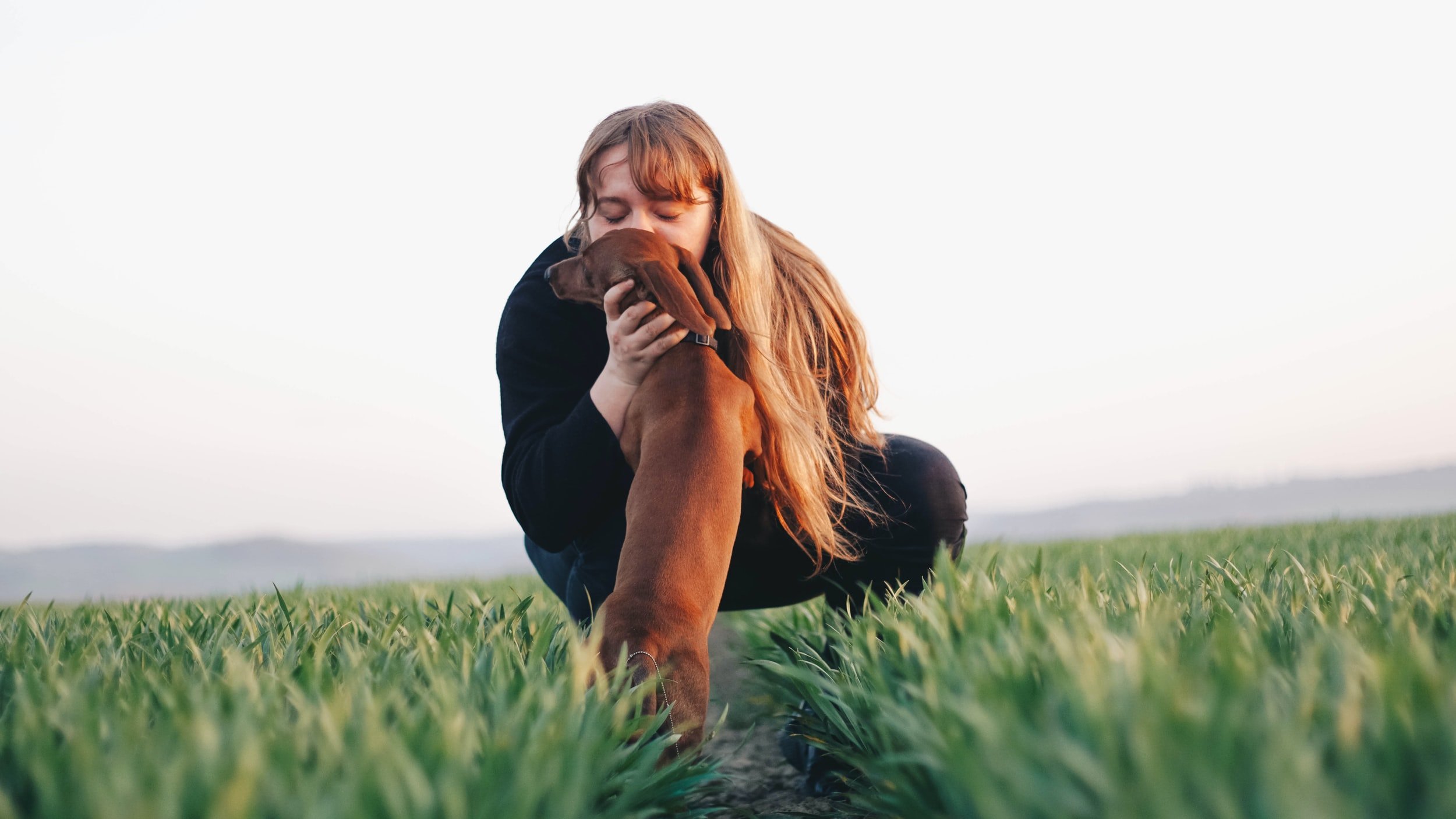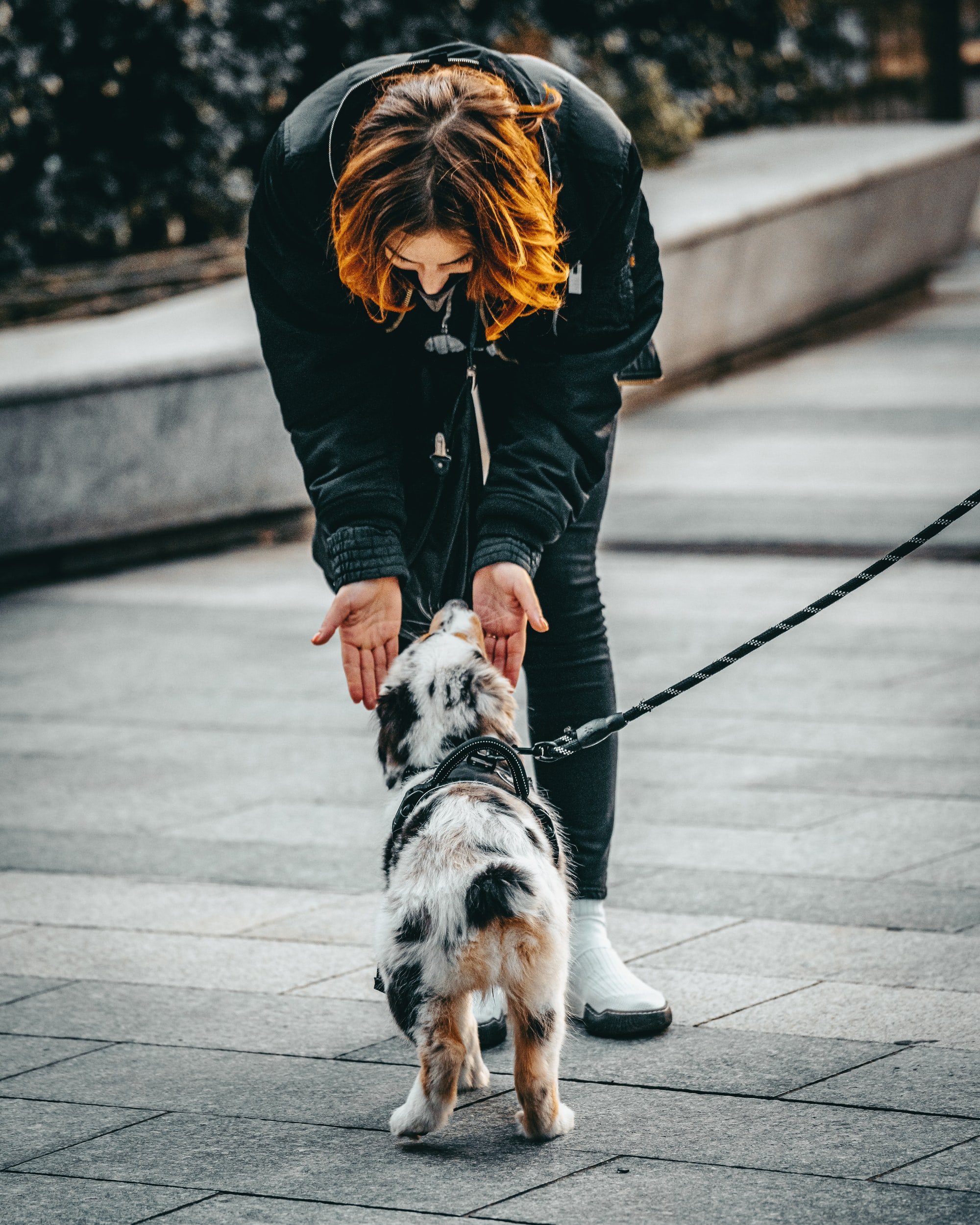How to stop your dog from jumping up on people (Photo: terrier jumping up)
Does your dog jump up on your houseguests? Strangers you meet out on your walks? Your kids? Your life partner?
When dogs jump up on people, people can easily get injured. I’ve helped clients who have been enthusiastically bonked in the face leading to fat lips, sore jaws, and bleeding tongues. Not to mention the scratches that can be left behind when dogs jump up on people.
Whether you’re teaching a small puppy not to jump up, or a new rescue dog, we’ve got tips for you.
Let’s get into some tips to help prevent and teach our puppies and new rescue dogs not to jump on human beings.
Clear Communication — If you don’t want your dog to jump on your grandma, don’t allow her to jump on anyone. Keep it simple and clear for your puppy/dog from day one. It’s the easiest way to clearly communicate what is allowed (four on the floor) and what is now allowed (jumping up on people.)
Be clear and consistent with your puppy (Photo: person kissing a Dachshund while it’s jumping up on them)
2. Leash on — Leave a lightweight leash on your puppy to prevent them from getting those paws up onto people, because you know what will happen next: the person that’s getting jumped on will likely start petting your puppy. This reinforces that jumping on people is awesome. We don’t want that, so prevent it with your leash.
This will make it more likely that your dog will jump up (Photo: Frenchie pulling on a harness in front of its handler)
This dog is engaged with his owner and looking at them for direction. This dog is less likely to jump up on someone (Photo: dog laying beside his handler looking up at the handler)
3. Consistency — If one family member allows jumping up, mouthing, and hyper behaviour, your puppy will become confused. This isn’t fair to the puppy. What happens next? The same person who allows the jumping is yelling at the dog for jumping on Great Aunt Eva or a stranger. This is also very confusing to the puppy. Be fair and consistent from day one with your puppy or new rescue dog and you’ll see great behaviour from day one.
4. Clear Communication Meets Consistency — Oftentimes when a puppy jumps up, owners are shouting “down.” If the puppy has learned to lay down, they are confused. They’ve never learned to lay down whilst having two paws on grandpa’s leg. Use the word “off” for “get your front paws off of that person/object.” Reserve “down” for “lay down.” Be consistent throughout all family members so your puppy doesn’t get confused.
Be clear to avoid confusing your dog (Photo: two Golden Retrievers laying down on the floor)
5. Neutral People — To help teach this behaviour, have a friend or family member help you. This needs to be a person who can completely ignore your dog. Baby talking makes puppies jump up. For some puppies it also makes them pee. A person who stands rigidly and holds their breath will not bring the right energy (before a fight, dogs slow their breathing and stand with a stiff posture.) Bring in a friend or family member who can simply pretend your puppy doesn’t even exist. This allows your puppy to learn that when guests come over, they don’t need to jump all over them, they can simply be calm.
Not this friend/family member…(Photo: person leaning over a leashed dog and holding both hands out toward the dog)
Choose a friend or family member who can ignore your dog while acting completely natural and calm (Photo: three people having a conversation making eye contact with each other)
Remember: what we allow, we agree with. If you allow jumping, you’ll see more jumping.
When we are clear and consistent with our puppies and dogs, harmony comes that much faster into our homes.
What else can help your puppy learn not to jump on your houseguests?
Placework.
We need to teach our dogs what we want them to do instead of jumping up on people. When we teach our dogs to go to their place, it gives them a job when someone knocks on the door. You can also use placework when you’re out and about.
Give your dog the job of calm to prevent them from choosing their own job as protector or excited door greeter (Photo: two people having coffee inside a café while a dog is outside the café on a bench)
Another great tool is the crate. When introduced properly, a crate represents a safe place for your dog to go and rest. You may wish to let your dog out of the crate when they are calm so that they can hang out in the same room as you and your guests. Use your leash when you bring them calmly into the group. Instruct your guests (this is the hardest part of all) to practice no touch, no talk, no eye contact until your puppy calms back down. This is the proper way to greet dogs because it honours their nose. Shrieking in a high pitched voice and shoving your hand toward a dog’s face is not the way dogs greet each other. It can be very frightening to some dogs who will bolt away from that sound and space invasion. For dogs who prefer to choose fight over flight, this can become a bite.
How would you react to a stranger suddenly putting their hand in your face? Swat it away? Run? Your dog doesn’t appreciate their space being invaded either. Advocate for their space. Don’t allow your guests to invade your dog’s intimate space.
It’s time to normalize no touch, no talk, no eye contact as the way to greet a dog we do not know.
We need to stop teaching children that this is how we greet dogs because it can result in a bite (Photo: child making kissy lips and reaching his hand into a dog’s intimate space to be sniffed)
When your houseguests learn how to greet puppies and dogs in a way that is more natural, you’ll see an immediate decrease in your new rescue dog’s stress level and an immediate decrease in your puppy’s desire to jump.
Happy training, Dog Leaders!
Alyssa
Photos by: Julian Hochgesang @julianhochgesang (terrier jumping up,) Anna Dudkova
@annadudkova (person kissing a Dachshund while it’s jumping up on them,) Jingjie wong
@jingjiewong (Frenchie pulling on a harness in front of its handler,) Tamas Pap
@tamasp (dog laying beside his handler looking up at the handler,) Gulyás Bianka
@repetaesmese (two Golden Retrievers laying down on the floor,) Mikita Yo
@mikitayo (person leaning over a leashed dog and holding both hands out toward the dog,)
Alexis Brown @alexisrbrown (three people having a conversation making eye contact with each other,) Ross Sokolovski @ross_sokolovski (two people having coffee inside a café while a dog is outside the café on a bench,)
Chen Mizrach @chenhanozel (child making kissy lips and reaching his hand into a dog’s intimate space to be sniffed,)









